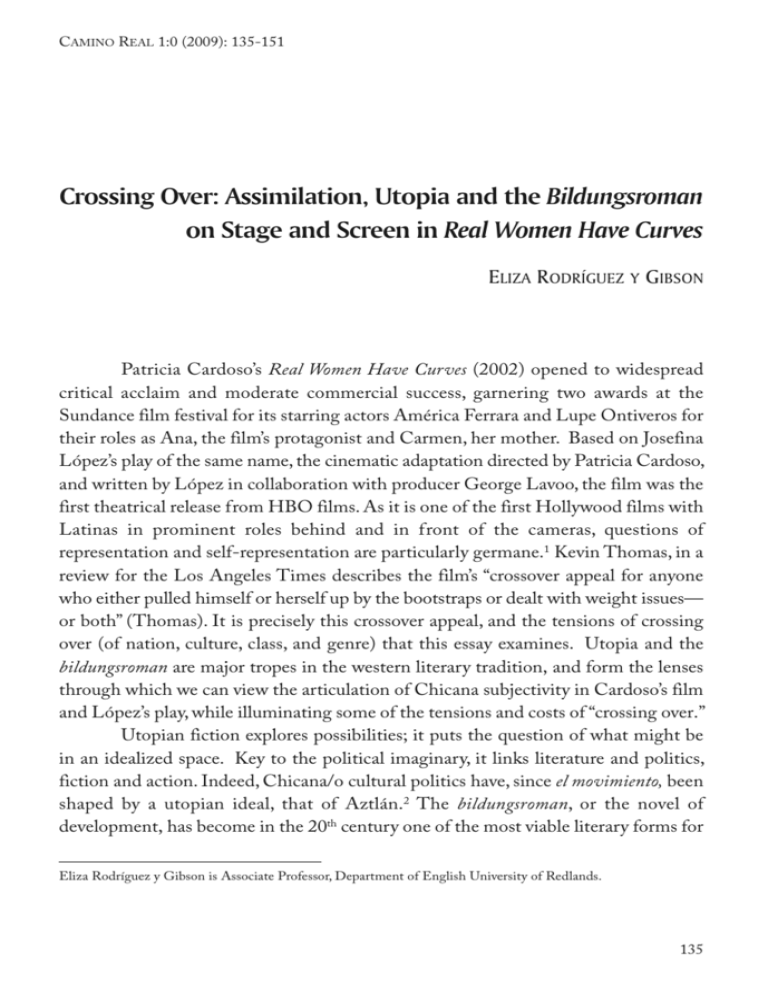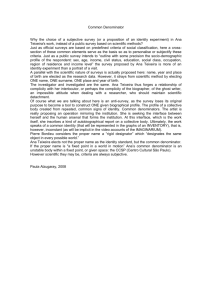Crossing Over: Assimilation, Utopia and the
advertisement

CAMINO REAL 1:0 (2009): 135-151 Crossing Over: Assimilation, Utopia and the Bildungsroman on Stage and Screen in Real Women Have Curves ELIZA RODRÍGUEZ Y GIBSON Patricia Cardoso’s Real Women Have Curves (2002) opened to widespread critical acclaim and moderate commercial success, garnering two awards at the Sundance film festival for its starring actors América Ferrara and Lupe Ontiveros for their roles as Ana, the film’s protagonist and Carmen, her mother. Based on Josefina López’s play of the same name, the cinematic adaptation directed by Patricia Cardoso, and written by López in collaboration with producer George Lavoo, the film was the first theatrical release from HBO films. As it is one of the first Hollywood films with Latinas in prominent roles behind and in front of the cameras, questions of representation and self-representation are particularly germane.1 Kevin Thomas, in a review for the Los Angeles Times describes the film’s “crossover appeal for anyone who either pulled himself or herself up by the bootstraps or dealt with weight issues— or both” (Thomas). It is precisely this crossover appeal, and the tensions of crossing over (of nation, culture, class, and genre) that this essay examines. Utopia and the bildungsroman are major tropes in the western literary tradition, and form the lenses through which we can view the articulation of Chicana subjectivity in Cardoso’s film and López’s play, while illuminating some of the tensions and costs of “crossing over.” Utopian fiction explores possibilities; it puts the question of what might be in an idealized space. Key to the political imaginary, it links literature and politics, fiction and action. Indeed, Chicana/o cultural politics have, since el movimiento, been shaped by a utopian ideal, that of Aztlán.2 The bildungsroman, or the novel of development, has become in the 20th century one of the most viable literary forms for Eliza Rodríguez y Gibson is Associate Professor, Department of English University of Redlands. 135 CAMINO REAL women and people of color because of the ways that it formalizes the process of coming to consciousness, voice, and subjectivity—central to the articulation of identity politics throughout the second half of the 20th century. It is a form which Chicana/o fiction has readily appropriated, from Pocho to The House on Mango Street. While both the film and the play share some basic elements of plot, character, and title, their differences are striking and instructive; reading Cardoso’s film against López’s play highlights the assimilation which crossing over, “bootstraps” and all, apparently demands. Both the play and the film construct utopian spaces within which Ana comes of age, and both López and Cardoso erect Chicana bildungsromane. The manner in which that narrative tradition is rewritten, and in which that utopian space is constructed, however, speaks volumes about the costs of crossing over: as Mexicanas/Latinas into the body politic of the United States, the mainstream film market, as well as the U.S. cultural imagination. The price of entry, it seems, is the play’s radical Chicana feminist politics. Cardoso’s film begins with an argument: Ana refuses to stay home on her last day of high school in order to make breakfast for the men of the family as her mother demands. We follow her as she leaves her mother’s house in Boyle Heights, a historically working class and Chicana/o neighborhood in East LA, crosses town and arrives at Beverly Hills High, where her English teacher, Mr. Guzmán actively encouraging Ana with her college application—in spite of her hesitance because of the cost. He comes to the family home on more than one occasion to speak with her parents, who remain steadfast in their opposition. Her mother, Carmen, is the most vocal in her protests, arguing to her husband that she herself had to work at the age of 13, and now it is Ana’s turn. It is clear that she is jealous, and not a little hurt that Ana isn’t satisfied with the domestic education she can offer her—to cook and take care of her future husband and children. Meanwhile, Estela’s sewing shop is in crisis— she has to complete an order of one hundred dresses and has lost two of her best seamstresses, a mother and daughter who are moving to Mexico so that the daughter, who is pregnant, can marry and start her family. Estela’s shop is in such debt that eviction looms over them, and she cannot pay her staff. Ana is caught between helping her sister by working in the shop, therefore submitting to the wishes of her parents, and following her own ambitions. Throughout the film, Ana is constantly fighting with her mother, mostly over Carmen’s insistence that Ana lose weight. Ana begins a secret relationship with Jimmy, a classmate, and with the help of her grandfather is able to sneak out to see him. Meanwhile, she has convinced Estela to appeal to the contractor Mrs. Glitz, (who turns out to be Latina) for an 136 ELIZA RODRÍGUEZ Y GIBSON advance, but to no avail. At the height of Estela’s financial difficulties, Ana surreptitiously approaches their father for a loan for the shop, which he easily provides. Ultimately, the women complete their goal, in spite of the heat; Estela refuses to turn on the fans because they would blow dust on the dresses. As they near their goal, Ana begins to undress because of the oppressive temperature, and all of the women (except for Carmen) follow suit as they try to “outfat” each other, comparing stretch marks and cellulite, much to Carmen’s dismay and vociferous protest. Laughing and dancing at their sewing machines, the rest finish working in comfort and self acceptance. Estela designs and makes a dress for Ana, which remains on the hanger. Ana repays her father, and receives his blessing to go to New York. She is accompanied to the airport by her father and grandfather: her mother refuses to leave the bedroom to give Ana her blessing, while Estela goes to work. The film ends with Ana emerging in Times Square, confident and looking very polished. What is at stake in imagining a Chicana subject in literary and cinematic space? What’s gained or lost in crossing over? Compared to the original play, the film seems assimilationist, and this is the main complaint from a politicized audience.3 This comparison inevitably prompts the question: Is any assimilation acceptable? López has clearly invested funds from the film into her theater, Casa 0101, which exists to “bring live theater, digital filmmaking, dance and art to Boyle Heights so as to nurture the future storytellers of Los Angeles who will some day transform the world” and offers classes in playwriting, screenwriting, and digital filmmaking (josefinalopez.com). The success of the film has also increased the audience not only for López’s projects, (her own and those produced by Casa 0101), but also potentially for additional Latina/o films in the mainstream. Two distinct aims are visible in the play and the film; the former articulates a radical Chicana feminist subjectivity, while the latter constructs a Chicana subject visible to the mainstream. Many of the plot shifts from the play to the film to the play suggest that audience determines the story: the shift in focus from Estela to Ana, giving Ana a white boyfriend, and creating an abundance of sympathetic and supportive male characters ensures that audiences who may have felt excluded from López’s original vision (men, white people) can see themselves here. Ana’s feminism seems to mostly involve appropriating traditionally masculine behavior—even to the point of hyperpracticality as she breaks up with Jimmy after sleeping with him before she goes to New York. Nonetheless, this is what a mainstream audience would recognize as feminism: a girl free to act like a boy if she wants to, if this is what freedom and growing up means for her. 137 CAMINO REAL Many of the plot elements in the film are drawn from the play, the scope of which is geographically smaller, but thematically much more expansive—focusing not on individualism, but a sense of collective identity and purpose. López’s play is divided into two acts, and it takes place entirely inside Estela’s tiny sewing factory in Boyle Heights. The plot focuses on the completion of one hundred dresses by the five women working in the factory: Estela, the shop owner, Ana, her younger sister; their mother Carmen, and two others, Rosalí and Pancha. Since the play is set entirely inside the shop, what we learn about the outside is accomplished entirely through chisme, (gossip). Through their chisme, the women come to discover that Estela is not documented, unlike the rest of them (some of them very recently). Various scares about an impending immigration raid punctuate the play—mostly based on Carmen’s reports of seeing the INS van outside.4 Again, through chisme, we learn of Estela’s romantic interest in a man mostly referred to as El Tormento, as well as Rosalí’s eating disorder (she lives on water, pills and a tomato juice per day). Rosalí collapses and has to be taken home, (the effects of her self-starvation), but returns the next day—crucial to the completion of the dresses. Not only is she a skilled seamstress, but she is also the only one who can work an overlock machine. Estela goes on a disastrous date with El Tormento: he is drunk when he comes to take her to a drive-in so that no one will see him with her. After five long hot days, they complete the dresses. The much commented upon and celebrated scene of the women taking off their clothes as they try to “outfat” one another originates here, and everyone, including Carmen, accepts their bodies and works in some relief from the heat, which is worsened not only because the fans are off, but also because the doors are closed and locked out of fear of la migra. Eventually, we come to learn that the supposed INS van which Carmen has been panicked by and panicking everyone in the shop with, is actually a police van—setting up a sting operation to arrest El Tormento, who turns out to be a drug dealer. Finally, with the contract for the dresses completed, Estela can finally pay the women. They decide, in spite of their own needs, to loan her most of their paychecks, so that she can pay off the shop’s debts and her own legal fees. Estela can then free all of them, finding a contract with a Latino business and ultimately opening her own boutique which specializes in large sizes, “Estela García’s Boutique Real Women Have Curves.” At the play’s close, the women stage a runway style fashion show, wearing the dresses which they have presumably made. Perhaps the most striking contrast is the emplacement of the film and the play. Clearly, the demands and effects of genre are at work, nonetheless the 138 ELIZA RODRÍGUEZ Y GIBSON geographies of the drama construct different sorts of Chicana utopias—the perfect setting for a Chicana coming of age story. The film very clearly establishes a sense of place, while the play refuses one. Utopia, as originally coined by Thomas More in the 1516, is the perfect place that is no place—from the Greek adverb ou, meaning “not” and noun, topos, “place”, added to a Latin suffix, ia; even its etymology is not from a place on any map. Among its other features, More’s Utopia is a kind of travel writing—narrated by the explorer Hythoddy, another Greek compound meaning “nonsense peddler.” Roland Shaer notes that “by consigning his invention to the literature of travel in which the political imaginary assisted by fiction, can freely roam, More has endowed the literary genre with a formal matrix” (2). The real world implications of fictional places, then, matter deeply. Most importantly, utopias contain within them the very seeds of their undoing.5 In More’s narrative, in order to maintain its ideal state, the Republic becomes repressive: moving individuals with no regard for their wishes from one household to the next to maintain the perfect population density, declaring war on its neighbors to attain territory to sustain its populations, and even limiting personal movement, such as walks in the countryside. Of course, all this is in the context of an ongoing philosophical dispute over whether it is possible for a commonwealth to be both moral and expedient. 6 Nonetheless, this revisiting of More serves to make a larger point: that utopias are impossible places—they are literally noplace, to make it some place is to unmake it. Over the past 30 years, Aztlán has consistently been articulated as a spiritual and metaphorical place of belonging, rather than as a geographical point on a map. Even Anzaldúa’s famous reimagination of Aztlán as the borderlands is defined as primarily liminal, protean and in constant flux.7 The demands of realism and of narrative cinema however, require a place for the plot, trumping the radical politics of the play’s setting. Margo Milleret reads López’s play as “more utopian than real” offering a “nurturing environment that not only mediates between home and society but also has the potential to infiltrate both” (110). The place of the play is the sewing shop. The set never changes. Its details are realistically constructed by the sewing equipment, a Mexican calendar, food and other personal effects of the women inside, described concretely in the stage directions. Still, the shop is a sealed room. While it is a room that is specifically a Chicana space, it is simultaneously nowhere and anywhere at once: it could just as easily be in Chicago, San Diego, San Antonio, or any other Latina/o city in the U.S. Francisco Lomelí makes the important point that “the subtext of the play concretely appears as a response to the 1987 Simpson-Rodino Amnesty law designed to stop the influx of undocumented people entering the U.S. 139 CAMINO REAL by granting real residency to thousands living in the U.S. since 1982” (153). First performed in 1990, and published the following year, the play setting coincides with this legislation—dates are given in the script. Hence it follows the utopian convention of taking a real political question, and testing it out in a fictional space. That López places all of the action in such a marginal “noplace” setting ideally describes the social location of these women. Moreover, the play’s action continually sets the events and conversations of the inside against the threats of the outside—especially an impending raid by la migra. Critics have extensively commented on the themes of entrapment in López’s play; the specter of la migra means that the doors remain closed and locked making it airless and hot, and the women silence each other to avoid detection inside. Lomelí describes “the reduced quarters of an asphyxiating working space (a kind of hell) [which] becomes emblematic of their condition as workers and as women” (154-5). Their condition is shaped by their confinement, a spatialization of their limited options: lack of access to education, money, mobility. By concentrating all of the dramatic action within this less than ideal space, López’s characters have no choice but to negotiate it, which they do largely through language: all of them through chisme, and Ana through her journal writing—which she does locked in the bathroom. Lomelí points out that “the play thematically creates a safe zone [and the women] appropriate it as theirs after elimination of the layers of contestation and tension among them—in great part, thanks to humor” (153). The humor he refers to is created almost entirely in chisme, which is explicitly prohibited not only by Estela’s sign in the shop (she believes it will detract from a productive and professional atmosphere) but also by the norms of proper feminine behavior. In the margins of class, race and gender, however, chisme is the only avenue for information and exchange these women have. Moreover, as Milleret points out, chisme’s “ability to engage and connect the women to each other, helps them gain a greater sense of self-esteem and selfhood. At the same time, chisme breaks down the barriers between the women and their cultural values” (119). The famous scene in which the women take off their clothes to compare stretch marks embodies the power and pleasures of chisme.8 That it is the only scene repeated in the film points to its centrality in the narrative. It is López’s “vehicle to female solidarity” in the play, and it is in chisme’s informal register that Ana speaks in her feminist efforts to educate the others about their rights as workers and as women (Milleret 119). The reclamation of Chicana voices, bodies, and the labor that these bodies produce is a central theme of López’s play. It is only after this scene in which the 140 ELIZA RODRÍGUEZ Y GIBSON women reclaim their bodies that they can imagine wearing the sorts of dresses that they work on—indeed Estela’s boutique is the logical outcome of this process. Conversely, Ana is the only character in the film that is presented with the option of wearing such a dress. Elements of the public and the private are inscribed on the bodies of these women: their immigration status and their “fatness” are emblematic of their marginalization. As María Figueroa convincingly argues, these two elements are indicative of “social inclusion and the possession of a socially livable body—a body that matters in the sphere of democratic equality” (272). Negotiating these two aspects is crucial to Ana’s development in the play. Her maturity is reflected in the excerpts from her journal which we hear her read periodically, as she retreats into the bathroom (the only private space in the play). At first, she is scornful of the women and their work, aware of the conflicted position she inhabits: “It’s as if I’m going backwards. I’m doing the work that most illegal aliens do… (Scratches illegal aliens). No, ‘undocumented workers’… or else it sounds like these people come from Mars” (López 10). In highlighting this difference of naming, Lopez, through Ana voices the crucial difference between the two; the former dehumanizes and estranges, while the latter does not. By the end of the play, Ana has matured to the point where she respects the hard work, the “puro lomo” that these women do as she goes to college and returns home. In one line López indicates the success of both Ana and the women in the shop, “When I came back the plans for making the boutique were no longer a dream, but a reality” (69). Thus, Ana’s dreams as well as the women’s dreams become attainable plans. Her development is linked entirely to theirs. As a form originating in the 18th century, the bildungsroman, the novel of development, has been appropriated and reimagined by women and people of color throughout the twentieth century.9 According to Pin-chia Feng, “the emphasis of a Bildungsroman on repressive environmental factors, on the process of disillusionment necessary for personality change and maturity, and on the possibilities for transformation offered by individual choices makes it an attractive genre to modern women intent on expressing female awakening and consciousness-raising and on proclaiming new, self defined identities” (77). Moreover, as Annie O. Eysturoy writes of Chicana forms of the genre, the focus on self-definition makes it an ideal form for articulating an empowered subjectivity. Eysturoy notes that this dynamic makes it “one of the most viable literary forms in women’s and minority literature” (11). Writing of Asian American literature, Patricia Chu astutely identifies a dynamic that also shapes Chicana/o literature: “Because culture—specifically the Bildungsroman— is a site for imaginatively transforming readers and protagonists into national subjects 141 CAMINO REAL by erasing or containing their particular differences, Asian American literature reinscribes those differences in an alternative version of the genre, one in which authorship signifies not only the capacity to speak but the belief that speech—or literary representation—is also a claiming of political and social agency” (3). The primacy of language in Real Women Have Curves, the immediacy of Ana’s journal entries, and the key role of chisme are interdependent and articulate the empowered Chicana subjects by the play’s end By placing Ana’s coming of age story in the context of a community of working class Chicanas, set in a marginal, and invisible-to-the-mainstream space, López successfully constructs a Chicana utopia in which a group of women come to consciousness and self-determination. Rewriting the bildungsroman for her own purposes, López creates a narrative of development that connects all of the characters in solidarity as workers and as Chicanas. Lomelí describes the play’s thematics as a series of concentric circles, with the feminine family unit forming the central one, with others extending outwards. The center remains, and while Ana does eventually leave for college, she returns home at the end of the play. This dynamic reshapes the form from a linear movement of progress outward, to one which circles back to origins. The plot of the film, in contrast, is strongly linear. Ana’s mobility extends from crossing the city to crossing the country; the film opens and closes with her leaving home. Ana is a consummate border crossing figure: from East LA to Beverly Hills, from home to school to work, and ultimately from LA to New York. The film’s plot highlights the tensions with other women that her movement engenders: the conflicts are almost exclusively feminized, and the women in the film embody tradition, stasis, and ultimately repression. While Estela is not married, she does live at home and doesn’t seem very happy even after her business crisis is averted. In contrast to her fraught relationships with her mother and sister, Ana is very affectionate with her grandfather, who tells her tales of adventure and discovery. In the film, Ana’s coming of age story is modeled on this traditionally masculine model of adventure and discovery. While the film is not a novel, many of its narrative conventions are novelistic. Lisa Lowe reads the bildungsroman as a narrative that effaces difference in order to produce national subjects. She writes, “the novel of formation has a special status among the works selected for a canon, for it elicits the reader’s identification with the bildung narrative of ethical formation, itself a narrative of the individual’s relinquishing of particularity and difference through identification with an idealized ‘national’ form 142 ELIZA RODRÍGUEZ Y GIBSON of subjectivity” (Lowe 98). The film follows the process of Ana becoming a national subject; she quite literally moves from sea to shining sea—from LA to New York. The changes in plot from play the film serve to center the narrative of Ana’s development over every other element. Feminist critics of the bildungsroman have repeatedly pointed out the masculine origins of the genre and how feminist writers have repeatedly rewritten and reimagined the form. While we might call Ana a feminist heroine, what with her positive body image and headstrong ways, she is also relentlessly male-identified. Her closest and most supportive relationships are with men: her grandfather, her father, her male teacher, and her white boyfriend. That neither her mother nor sister sees her off to the airport is no small thing. From the beginning Ana sees herself as separate from the women in the shop, and by the end of the film, while she comes to understand them, she does not see herself as one of them. The tensions between the plot of the film and its cinematic form highlight the negotiation between the assimilative demands of the coming of age drama (the bildungsroman which produces national subjects—the plot that appeals to the broadest audience) and the utopian space that Cardoso creates visually. While the story moves in a linear fashion, the cinematic framing suggests a circular movement closer to the thematic arc of the play. In their collaboration, López and Lavoo rewrite Real Women Have Curves to focus on Ana’s coming of age story. The legibility of that story depends on both the audiences recognizing it as such, as well as the author’s ability to position herself in relationship to mainstream cultural narrative conventions—in this case a coming of age story that privileges individualism and assimilation. The politics of immigration, arguably far more radical than body acceptance, are entirely dropped from the adaptation. Conversely, the visual elements of the story, the cinematic elements of a film, are almost always ignored by mainstream audiences—unless they are sensational (special effects) or in other ways demand the audience’s attention dramatically. Significantly, it is in the visual elements that we find Cardoso’s creation of LA as a Chicana utopia. Its legibility depends on the audience’s familiarity with the visual language it invokes. Cardoso’s investments in representing Los Angeles as a Latina city rewrite mainstream representations of both the city and its Latina/o inhabitants. Los Angeles is a city whose image has little to do with its reality; Hollywood is actually a working class Latina/o, Thai and Armenian neighborhood. Most images, however, of Hollywood and of Los Angeles are glamorous, and alternatively sanitized or “rock and rolled”, and almost always white, or black and white; Latina/os do not exist in 143 CAMINO REAL Hollywood’s LA. The metonymic relationship between women’s bodies and Hollywood (and by extension, LA) is as old as the movie industry; its female stars are famous primarily for their physical attributes (think of Marilyn Monroe’s platinum hair and hourglass figure) and stand in for the very idea of Hollywood. Of course, the identification of women’s bodies and geographies, conceptual and literal, is much older: colonial narratives describe the Americas in female forms, as virgin lands to be conquered.10 Given this repressive history, Cardoso’s identification of Ana’s body with the city is potentially fraught with contradiction; while Ana embodies the city, she eventually assimilates and leaves it. Cardoso, then, negotiates the terrain between appropriating a potentially colonizing trope (woman’s body as geography) and imagining a Chicana body politic. If More’s Utopia is the imagination of an ideal republic, Cardoso’s utopian LA imagines a place in which Chicana subjectivity is at the center, and Chicana bodies matter.11 The film Real Women Have Curves opens and closes following Ana as she walks though two different cityscapes—beginning in Los Angeles and ending in New York, bringing spatialized closure to this particularly Chicana bildungsroman. If, as Doreen Massey suggests, places are social relations “stretched out” what is at stake in cinematic representations of Chicana bodies moving through cinematic places (5)? The film establishes a metonymic relationship between Chicana bodies and the city of Los Angeles suggesting that Ana is a walking, talking body politic. If real women have curves, then real cities have buses, sewing shops, and taquerías. Cardoso is drawing on a realist tradition in cinema perhaps most famously embodied in the Italian neorealist movement of the post WWII era. In celebrating these quotidian places and the people who inhabit them, Real Women Have Curves constructs Los Angeles as a place of utopian possibility —one in which Chicanas are free to move not only across the city, but most importantly across the deeply fraught class lines represented by education and travel away from home. Ana commutes across town to attend Beverly Hills High School, has a secret (white) boyfriend, and even preaches a feminist gospel of body acceptance—embracing her curves in the face of a culture (or cultures) that judges women by their degree of slenderness. Because Ana’s body matters—as young, female, and of color, Cardoso resists objectifying her; we never see Ana’s body on display in the dress made by Estela, nor do we see her body in the bedroom with Jimmy. Instead, we see Ana’s face reflected as she stands before a full-length mirror as she looks at her boyfriend, who is in turn looking at her body. She has just interrupted their love-making to demand that he acknowledge the reality of her body, by looking at it. Ana’s subjectivity as 144 ELIZA RODRÍGUEZ Y GIBSON simultaneously looking and looked-at is central in that scene, complicating traditional models of scopophilia; while she is looked at, it is not by the camera or the audience, but by another character onscreen. Rather than negate the gaze, Cardoso foregrounds it: it replaces the female body as the primary subject in the shot. In both the film and the play, Ana’s liberated attitude towards her body and those of the Chicanas around her centers specifically in rejecting her mother’s traditional Mexican expectations of womanhood of wife-and-motherhood, which can only be accomplished by way of physical beauty, which is of course found in a thin body. Troublingly, this form of oppression is laid entirely on her mother’s doorstep. In the film, what is most promising in Ana as Chicana feminist heroine is also frustratingly assimilationist: all of her ideals of success demand a rejection of the women that have raised her, and her rejection by them: her mother and elder sister refuse to take her to the airport—instead her father and grandfather are her main supporters in her campaign for education and independence. The film sets up a clear dichotomy: stay home and work in the factory with the women, or go to New York to attend Columbia. One would think that there are no universities anywhere near Los Angeles. To be sure, this is a purely dramatic device, serving the plot, if not reality. These are the choices the film provides our heroine. Ana’s development depends on moving geographically away from these traditionally feminine Mexican roles, of subservience and domesticity to independence from her family. In the adaptation to the screen, López shapes Ana’s story according to the demands of the traditional bildungsroman, rather than the radically Chicana feminist revision she creates in the play. Cardoso’s framing of Ana presents her not only the young Chicana who is faced with these difficult choices, but also as a mirror image of the Chicanas around her who are denied these choices. Most importantly in Cardoso’s vision, Ana stands as an embodiment of the Chicana city that has raised her: she is at home on its streets, arguing with her mother as easily inside the home as outside it. The women who lack Ana’s social mobility (the better to highlight Ana’s education as a form of privilege), however, are hardly meek— as in the play, being quick witted is a form of power. In the sewing shop Pancha counters Ana’s bratty initial claim, “I’m just working here until I can find a better job” with “oh yeah, me too, I’m just working here until I win the lottery” (Cardoso). Throughout the film, Ana is repeatedly shown on foot, walking through the streets of East LA—recognizable by the downtown LA skyline and the Spanishlanguage signage. Neither is glamorous; the shots are literally and figuratively pedestrian, resisting romanticized notions of the city and of women’s bodies. This 145 CAMINO REAL metonymic relationship is established in the opening walking sequence of Ana making her way from East Los Angeles to her last day of school at Beverly Hills High. This transitional series of shots and pans connects two different locales: the mother’s bedroom (where Ana has just had an argument with her about staying home to make breakfast for the men) and Mr. Guzmán’s English class where students are sharing their post-graduation plans for college and graduate study. Again, liberation is advocated, not by the women in Ana’s life, but by a man. As Ana leaves her mother’s house, she passes and greets the old woman who sings in the opening credits, crosses streets, walking past taquerías, bakeries, butcher shops, and numerous murals, one which depicts the skyline and loudly proclaims “this town I live in” beneath.12 She changes buses twice before finally arriving in Beverly Hills: indicated by road signs at the city limits. Ana is dressed plainly, wearing a long sleeved green t-shirt that reveals her shape with dark jeans and sneakers, and she carries a backpack. She wears no makeup, and her hair is in a simple ponytail. She is shown squinting in the sunlight, striding purposefully down the streets, on her way to the bus stop. Her gait, which is criticized by her mother, is heavy and quick. She is rushing to school, changing her backpack’s position several times during the journey. The medium and long shots in this sequence focus on Ana’s body, and her seemingly unconscious way of walking: she doesn’t seem to care if her breasts bounce, or that she’s wrinkling her face in the sun. Ana is shot in silhouette against the city’s skyline as she crosses the street at several points in the film: the first time we see this shot is in the opening walking sequence. The city functions as her frame, and this initial depiction of it gives us a sense of its particularly Chicana character. That these shots are filmed on location in Boyle Heights, the neighborhood in East LA of the film’s setting, underscores Cardoso’s realist investments in representing the city as specifically Mexican and working class—crucial to the representation of Ana and her family as working class Mexicans in LA. It makes this particular milieu, invisible in most cinematic representations of Los Angeles, not only visible but more importantly normative. In contrast, Beverly Hills is only represented very briefly: the inside of a classroom and the street outside of her white boyfriend’s house are the only times we see it. The sequence of quick cuts between Ana walking, pigeons taking flight over the top of a church, and two itinerant musicians, back to Ana suggests that they are all of a piece. All of them are part of the cityscape, and seeing one influences how we see the others. The shot of the pigeons evokes the charm of the city, while the musicians in their matching suits suggest both romance and their daily struggle to find 146 ELIZA RODRÍGUEZ Y GIBSON work. The music and lyrics played during this quick sequence evokes this combination of both romance and struggle: “Soy una chica difícil pero yo valgo la pena. Yo busco un santo, un gran romeo que por mi vaya, vaya hasta el cielo” (“I am a difficult girl, but I’m worth it. I’m looking for a saint, a grand romantic who would go for me, go all the way to heaven for me”) (Cardoso). Significantly, the lyrics remain untranslated, and as the music is non-diagetic, it frames the film’s reality. This reality, then, is shaped differently for audiences who do and do not speak Spanish. That the song is performed by Quetzal, a local L.A. band famous for its Chicana feminist politics adds another layer of significance—the meaning of the sequence is richer for audiences who possess greater degrees of local knowledge. For other audiences the music and the cityscape become atmospheric, rather than specific. These cinematic elements foreground a thoroughly Chicana/Latina frame of reference—a rarity in Hollywood film. Not only is the city represented in extensive realist detail, but we are allowed to see the grime inside of a bus’s window; the camera cuts from the window to Ana scowling, perhaps remembering the preceding fight with her mother, perhaps at the interruption of the bus’s chime to her reading. More importantly, the city is framed by the dirty bus window, the camera lingers there for a few moments, allowing our eyes to see the street through that window. We are from the beginning of the film, being asked to see the world through this particular window, through the eyes of anyone on this bus, the Pico Rimpau 31—the busline is clearly visible as Ana disembarks to change busses. Paying attention to spatial dimensions of social relationships has proven enormously instructive in the analysis of Chicana/o literature. A particular place is the embodiment of social relations that have taken on social dimensions. Those social dimensions are continually changing, and informed by histories that are always in flux. As Doreen Massey notes “what gives a place its specificity is not some long internalized history but the fact that it is constructed out of a particular constellation of social relations, meeting and weaving together at a particular locus”(154). The family is the primary social group in this film, and their relations shift in different locations: inside of Estela’s sewing shop, Estela is the authority, and while Carmen sarcastically addresses her as “mi general” she still answers her daughter’s orders. The city becomes primarily a Chicana city because of the relationships represented in its various locales. The Los Angeles of Cardoso’s film is a Mexican city, populated primarily by Latinas. The particularly Chicana nature of LA makes us see LA as Ana’s home. And if she ever hopes to “grow up”, she has to leave home, not only her mother’s 147 CAMINO REAL house, but also her mother’s city, and by extension, her mother’s whole world. Many of the narrative’s pivotal scenes take place outside of the home: Ana defies her mother at Estela’s sewing shop on more than one occasion, they argue on the sidewalk, again over lunch at a taquería, where she defies her mother’s order to not eat some flan (she immediately takes a large bite). Ana’s ease of movement in and out of the public and private is singular; most tellingly Carmen cannot leave the parental home at the movie’s end: she does not come out of her bedroom to give Ana her blessing, mirroring her attempt to manipulate her daughter at the start of the film. By staying in bed sick, Carmen is trying to guilt Ana into obedience, and perhaps more poignantly into proving that she cares for and will take care of her. Instead at the end, just as at the beginning, Ana affirms her own plans: first to go to her last day of high school, and finally to leave for New York to attend Columbia. This stubborn insistence on her own plans to education frames and affirms Ana’s maturity according to the film’s assimilationist logic. Negotiation of the two extremes is never a possibility, as each of these options becomes embodied in two diametrically opposed characters. Estela completely drops out of the picture; there is no elaboration as to why she becomes estranged from Ana. The audience wonders what transpired between them to keep Estela from seeing Ana off at the airport. Cinematically, the film circles around to end where it begins; in the mother’s bedroom, followed by Ana striding down a city street. While the plot denies any return, the images suggest otherwise. Still, in the tensions between assimilationsist bildungsroman and Chicana utopia, the former wins out—shaping in the films final frames, a vision of Ana as a fully developed national subject. The film’s closing shot shows Ana climbing the stairs of a New York subway station, as she enters Times Square. The contrast between the realist depictions of Los Angeles and this very brief appearance of New York’s perhaps most mythologized locales is striking. LA is represented by a neighborhood where people live, Boyle Heights and its very specific details. Times Square, in contrast, is not a neighborhood, but emblematic of the city. The difference suggests that New York, in all of its romanticized cinematic glory, represents a clean break from the past. It is the place of possibility, of new relationships to places. We don’t see the city through a dirty bus window, nor do we get the neighborhood details that define Los Angeles. Those details at the start of the film establish the familiarity of the city: LA is home. In contrast, New York is new: we, like Ana, are looking up and around at all of the sky scrapers and signs around her. This newness is inscribed onto Ana’s body as well; we see it in her face, her clothing, even her walk. 148 ELIZA RODRÍGUEZ Y GIBSON As she ascends the steps, the camera frames her in a medium shot; our attention is drawn to Ana’s face, framed by her styled and curled hair, and is cleanly made-up. Her previously adolescent backpack and sneakers have been replaced by boots and a messenger bag. The New York version of Ana is polished, self assured, and while she looks around at her surroundings perhaps in curiosity, her stride is confident, and more feminine than her walk in the opening of the film. It recalls an exchange where Ana’s mother admonishes her to “walk like a lady” and Ana clowns an exaggerated runway walk. This new walk embodies the ways that Ana performs her social mobility. The framing of her face by Times Square recalls Hollywood’s depictions of a young woman coming to the big city: Marlo Thomas in That Girl and Mary Tyler Moore in The Mary Tyler Moore Show, enormously popular television shows of the 1960s that focused on the adventures of a single young woman in New York City and Minneapolis, Minnesota, respectively; they both were in syndication well into the 1970s. Ana becomes the latest All-American girl, and her transformation is complete against this conceptual and visual backdrop of American popular culture. Cardoso’s construction of Los Angeles is a kind of utopian project: in this cinematic space, LA is reimagined as working class and Chicana, demanding visibility for what is traditionally marginalized. Ana’s story, however, is shaped by the demands of crossing over, to the mainstream and to a dominant notion of what adulthood entails (not living at home, for example). The contradictions and negotiations between the two impulses drive the film forward. Its assimilationist plot suggests that the only way for Ana to grow up is to leave home—reject Mexican womanhood, distance herself from this community of women and their power over her. Her journey to this final point, however, takes her directly through this community of women. She has to identify with them, work with them in the sewing shop, and understand herself as one of them. As she says to Carmen, “this is who we are mamá, real women” after they have stripped down to their underwear (Cardoso). This identification, however, is temporary; the dynamic of linear movement, of progress, demands that she move away from this particularly Chicana place. Instead of making this group of Latinas part of a series of intersecting circles or communities as the play does, the film constructs this community of women as the stage for Ana’s individual development. While Cardoso frames LA as a Chicana utopia, the plot demands that she leave it. Utopias are rarely sustainable; this one requires an urban space which is not home— New York, in order to function. It seems that, ultimately, Ana cannot live in the idealized Chicana space in the film. The demands of the traditional bildungsroman, adopted by López in this adaptation, make it impossible for her to go home again. 149 CAMINO REAL REFERENCES Abel, Elizabeth, Marianne Hirsch, and Elizabeth Langland. Eds. The Voyage In: Fictions of Female Development. Hanover, NH: University Press of New England, 1983. Print. Anzaldúa, Gloria. Borderlands/La Frontera: The New Mestiza. San Francisco: Aunt Lute, 1987. Print. Butler, Judith. Bodies That Matter: On the Discursive Limits of “Sex” New York: Routledge, 1993. Print. Cardoso, Patricia. dir. Real Women Have Curves. HBO Films, 2002. Chu, Patricia. Assimilating Asians: Gendered Strategies of Authorship in Asian America. Durham and London: Duke University Press, 2000. Print. Eysturoy, Annie O. Daughters of Self-Creation: The Contemporary Chicana Novel. Albuquerque: University of New Mexico Press, 1996. Print. Feng, Pin-chia. The Female Bildungsroman by Toni Morrison and Maxine Hong Kingston: A Postmodern Reading. New York: Peter Lang, 1998. Print. Figueroa, Maria P. “Resisting ‘Beauty’ and Real Women Have Curves” Velvet Barrios: Popular Culture and Chicana/o Sexualities. Ed Alicia Gaspar de Alba. New York: Palgrave, 2003. 265- 282. Print. Hoover Braendlin, Bonnie. “Bildung in Ethnic Women Writers” Denver Quarterly 17.4 (Winter 1983): 75-87. Print. Logan, George M. and Robert M. Adams. “Introduction.” Utopia. By Thomas More. Revised Edition. Cambridge, UK: Cambridge University Press, 1989, 2002. xixxix. Print. Lomelí, Francisco A. “Concentric Circles in Real Women Have Curves by Josefina López” Aztlán: Ensayos Sobre Literatura Chicana. Eds. Federico Eguíluz, Amaiia Ibarran, et al. Universidad del Pais Vasco, 2000. 151- 159. Print. —. Ed. Aztlán: Essays on the Chicano Homeland. Albuquerque: University of New Mexico Press, 1989. Print. López, Josefina. Real Women Have Curves. Woodstock, Illinois: Dramatic Publishing, 1991. Lowe, Lisa. Immigrant Acts: On Asian American Cultural Politics. Durham and London: Duke University Press, 1996. Print. Massey, Doreen. Space, Place, and Gender. Minneapolis: University of Minnesota, 1994. Print. Milleret, Margo. “Girls Growing Up, Cultural Norms Breaking Down in Two Plays by Josefina López.” Gestos 13.26 (1989):109- 125. Print. 150 ELIZA RODRÍGUEZ Y GIBSON Rothstein, Edward. “Utopia and its Discontents.” Visions of Utopia. New York: Oxford University Press, 2003. 1- 28. Print. Schear, Roland. “Utopia: Space, Time, History” Utopia: The Search for the Ideal Society in the Western World. Eds Roland Schear, Gregory Claerys. New York: Oxford University Press, 2000. 3- 7. Print. Sperling-Cockcroft, Eva and Holly Barnet Sanchez, Eds. Signs from the Heart: California Chicano Murals. Albuquerque: University of New Mexico Press, 1993. Print. Thomas, Kevin. “A Mother and Child Disunion” October 18, 2002. Los Angeles Times. <www.calendarlive.com/movies/reviews/cletreal18oct,0,7110080.story?coll=cl%2 Dmreview> 15 July 2004. NOTES 1 In this essay I use both Chicana and Latina to acknowledge not only the pan-Latina population of Los Angeles and the U.S., but also the fact that while López is Mexican, Cardoso is not; she was born and raised in Bogotá, Columbia. 2 Aztlán as a Chicana/o utopia, its possibilities, limitations and reimaginations has long been the subject of critical debate, especially within literary circles. For key writings on the subject see Lomelí (1989). 3 Students in my Chicana Feminisms seminar were very critical of this aspect of the film. Informal conversations among Chicanas who identify themselves as activists too, have often centered on this critique. 4 INS is the abbreviation for the Immigration and Naturalization Service, informally known as “la migra.” 5 Edward Rothstein argues the point convincingly in his lecture “Utopia and its Discontents.” 6 George Logan and Robert Adams illuminate the philosophical contexts in their introduction to Thomas More’s Utopia. 7 See Anzaldúa. 8 This scene has been extensively analyzed by every critic writing about the play: Milleret, Lomelí, and Figueroa, for example. All identify it an essentially important turning point in the lives of the characters and in the play. 9 Feminist and minority criticism has developed comprehensive theories of the development of the genre. Especially instructive are Abel, Hoover Braendlin, and Lowe. 10 I want to thank Nicole Guidotti-Hernández for reminding me of this crucial discursive history. 11 By using this phrase I am invoking Butler’s excellent framing of the discursive construction of the body; I am also purposefully avoiding the phrase “Chicana feminist Aztlán” because of its explicitly radical connotations, which don’t fit here. 12 Murals have played a key role in the articulation of group identity for Chicana/os, especially in the Chicana/o movement. See Sperling-Cockcroft. 151








